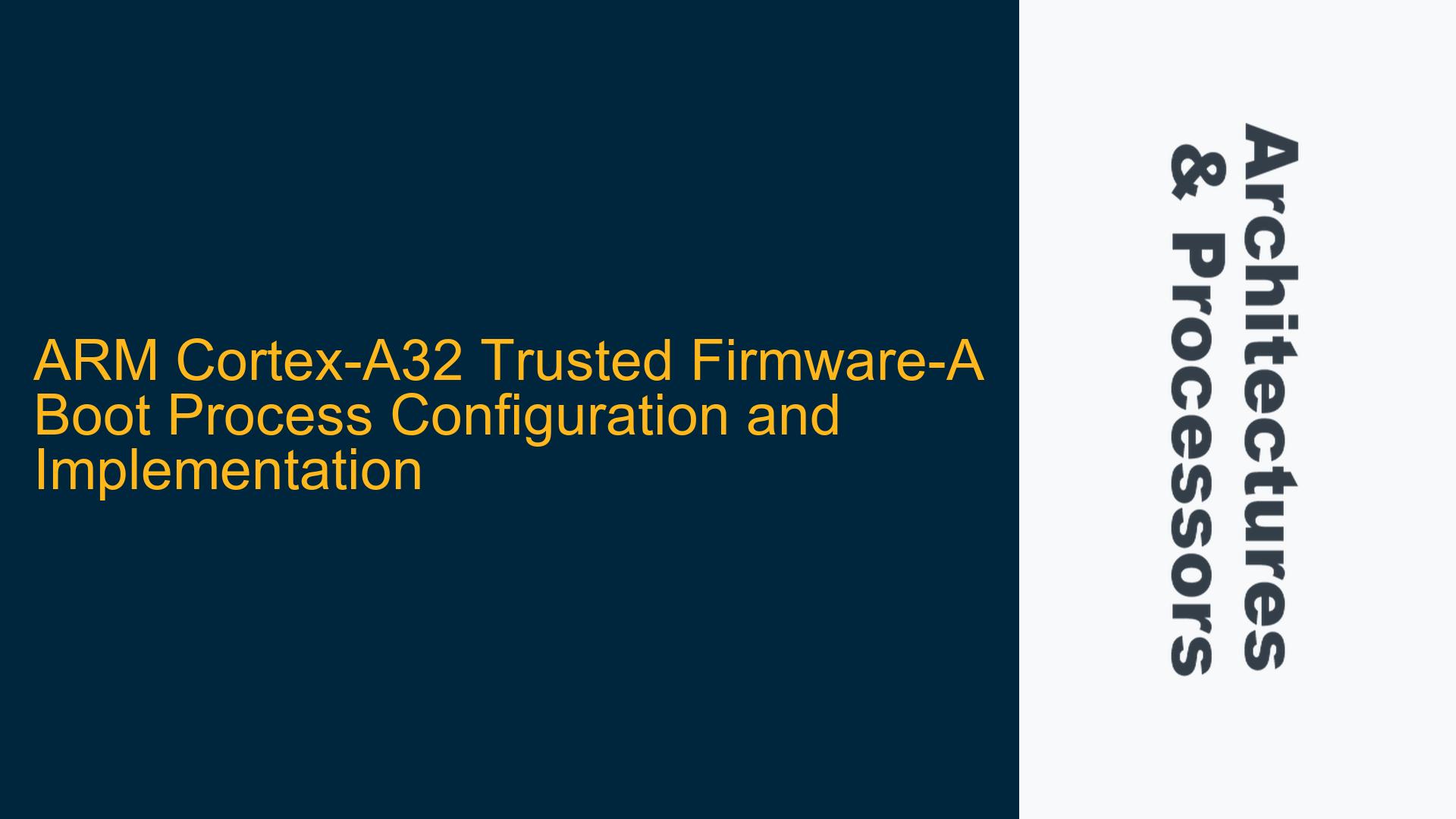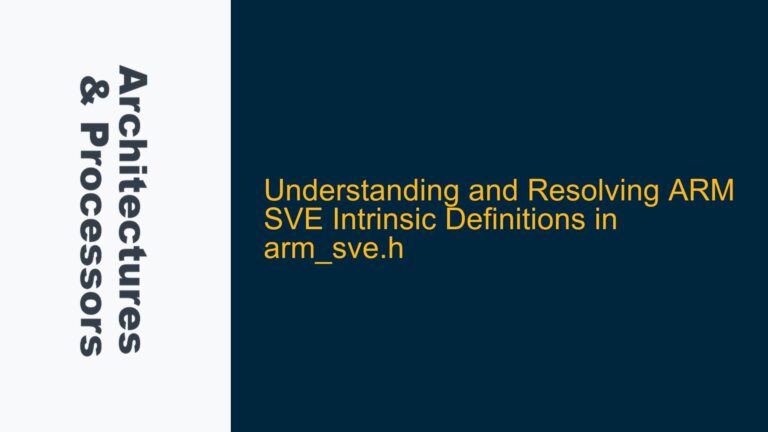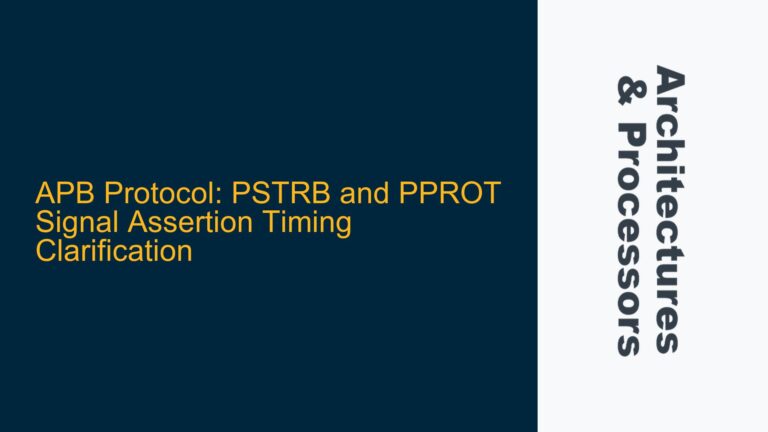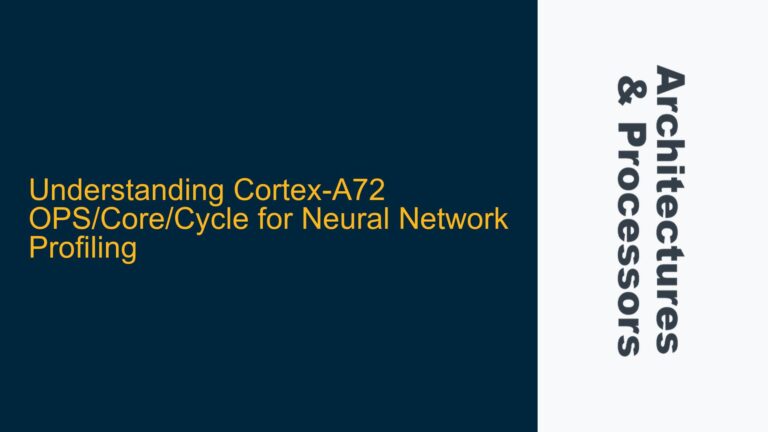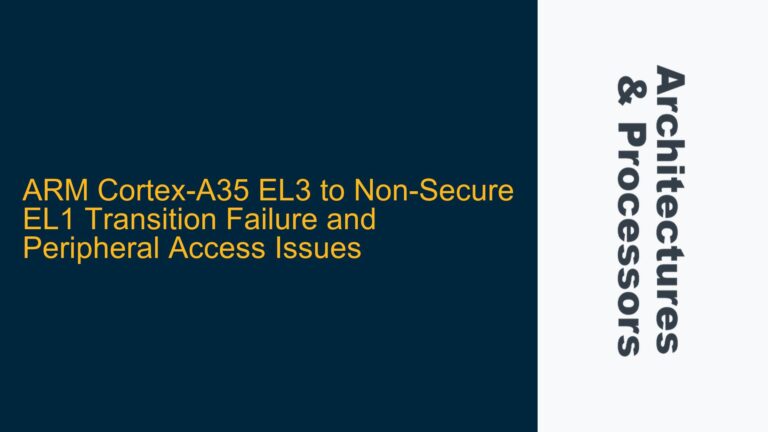ARM Cortex-A32 Boot Process with Trusted Firmware-A: Key Considerations
The ARM Cortex-A32 is a 32-bit processor core that implements the ARMv8-A architecture but operates exclusively in AArch32 execution state. This unique characteristic raises important questions about its compatibility with Trusted Firmware-A (TF-A), which is typically associated with 64-bit ARMv8-A processors. The Cortex-A32’s boot process, when using TF-A, requires careful configuration to ensure proper initialization and secure bootstrapping of the system. This includes understanding the role of BL1, BL2, BL31, and BL32/BL33 in the context of AArch32, as well as the correct setting of the ARM_ARCH_MAJOR build option.
The Cortex-A32’s AArch32-only nature means that while it inherits many features from ARMv8-A, such as improved virtualization support and enhanced security features, it lacks the 64-bit capabilities of its ARMv8-A counterparts. This distinction is critical when configuring TF-A, as the firmware must be built with the correct architecture settings to ensure compatibility. The ARM_ARCH_MAJOR build option, which controls compiler flags and architecture-specific code paths, must be set to 8 to reflect the ARMv8-A architecture, even though the Cortex-A32 operates in AArch32 mode.
The boot process for the Cortex-A32 using TF-A involves several stages, each with specific responsibilities. BL1 (Boot Loader Stage 1) is responsible for initializing the CPU and platform, loading BL2 into secure memory, and passing control to it. BL2 (Boot Loader Stage 2) continues the initialization process, loading the subsequent boot stages (BL31, BL32, and BL33) into memory. BL31 (EL3 Runtime Firmware) provides a secure monitor for switching between secure and non-secure states, while BL32 (Trusted OS) and BL33 (Non-Trusted Firmware, such as U-Boot) handle higher-level system initialization.
Configuring ARM_ARCH_MAJOR and AArch32-Specific Build Options
The ARM_ARCH_MAJOR build option is a critical configuration parameter when building TF-A for the Cortex-A32. This option determines the architecture-specific compiler flags and code paths used during the build process. For the Cortex-A32, ARM_ARCH_MAJOR must be set to 8, as the Cortex-A32 implements the ARMv8-A architecture, despite operating exclusively in AArch32 mode. This ensures that the compiler generates code compatible with the ARMv8-A instruction set and that the correct architecture-specific optimizations are applied.
In addition to ARM_ARCH_MAJOR, the ARCH build option must be set to aarch32 to indicate that the firmware is being built for a 32-bit execution state. This setting ensures that the build system selects the appropriate source files and configurations for AArch32. For example, the Cortex-A32-specific CPU initialization code, located in lib/cpus/aarch32/cortex_a32.S, will be included in the build. This file contains the necessary low-level initialization routines for the Cortex-A32, such as setting up the CPU registers and enabling architectural features.
The combination of ARM_ARCH_MAJOR=8 and ARCH=aarch32 ensures that the TF-A build process generates firmware that is fully compatible with the Cortex-A32’s ARMv8-A architecture and AArch32 execution state. This configuration also enables the use of ARMv8-A-specific features, such as virtualization and security extensions, while maintaining compatibility with the 32-bit execution environment.
Implementing BL31 and BL32/BL33 for Cortex-A32 Systems
The implementation of BL31 and BL32/BL33 for Cortex-A32 systems requires careful consideration of the processor’s AArch32-only nature. BL31, which typically operates in AArch64 mode on 64-bit ARMv8-A systems, must be adapted to run in AArch32 mode on the Cortex-A32. This adaptation involves modifying the BL31 initialization code to ensure that it correctly sets up the AArch32 execution environment and provides the necessary runtime services for switching between secure and non-secure states.
BL32, which represents the Trusted OS, must also be built for AArch32 execution. This includes ensuring that the Trusted OS kernel and associated drivers are compatible with the Cortex-A32’s ARMv8-A architecture and AArch32 mode. Similarly, BL33, which typically includes a bootloader such as U-Boot, must be built for AArch32 execution. This may require modifications to the bootloader’s initialization code to ensure compatibility with the Cortex-A32’s execution state.
The interaction between BL31, BL32, and BL33 is critical for the secure boot process. BL31 must correctly initialize the secure monitor and provide the necessary runtime services for switching between secure and non-secure states. BL32 must be able to execute in the secure state, providing a secure environment for trusted applications. BL33 must be able to execute in the non-secure state, initializing the rest of the system and loading the operating system.
To ensure a smooth boot process, the following steps should be taken:
- Build TF-A with the correct architecture settings: Set
ARM_ARCH_MAJOR=8andARCH=aarch32to ensure compatibility with the Cortex-A32’s ARMv8-A architecture and AArch32 execution state. - Adapt BL31 for AArch32 execution: Modify the BL31 initialization code to correctly set up the AArch32 execution environment and provide the necessary runtime services for secure state switching.
- Build BL32 and BL33 for AArch32 execution: Ensure that the Trusted OS and bootloader are built for AArch32 execution and are compatible with the Cortex-A32’s architecture.
- Verify the boot process: Test the boot process to ensure that all stages (BL1, BL2, BL31, BL32, and BL33) execute correctly and that the system boots into the operating system as expected.
By following these steps, developers can successfully implement the TF-A boot process on Cortex-A32 systems, ensuring a secure and reliable bootstrapping of the system.
Troubleshooting Common Issues in Cortex-A32 TF-A Implementation
When implementing TF-A on Cortex-A32 systems, several common issues may arise. These issues can stem from incorrect configuration settings, improper initialization of the AArch32 execution environment, or incompatibilities between the firmware and the Cortex-A32’s architecture. Below are some of the most common issues and their solutions:
-
Incorrect
ARM_ARCH_MAJORSetting: IfARM_ARCH_MAJORis not set to 8, the build process may generate code that is incompatible with the Cortex-A32’s ARMv8-A architecture. This can result in runtime errors or unexpected behavior. To resolve this issue, ensure thatARM_ARCH_MAJOR=8is set in the build configuration. -
Improper AArch32 Initialization: If the AArch32 execution environment is not correctly initialized, the system may fail to boot or exhibit unstable behavior. This can occur if the BL31 initialization code does not properly set up the AArch32 execution environment. To resolve this issue, review the BL31 initialization code and ensure that it correctly configures the CPU registers and enables the necessary architectural features for AArch32 execution.
-
Incompatible BL32/BL33 Builds: If BL32 or BL33 are not built for AArch32 execution, they may fail to execute correctly on the Cortex-A32. This can result in boot failures or runtime errors. To resolve this issue, ensure that both BL32 and BL33 are built with the correct architecture settings (
ARCH=aarch32) and are compatible with the Cortex-A32’s ARMv8-A architecture. -
Secure State Switching Issues: If the secure monitor in BL31 is not correctly initialized, the system may fail to switch between secure and non-secure states. This can result in security vulnerabilities or system instability. To resolve this issue, verify that the secure monitor is correctly initialized and that the runtime services for secure state switching are properly implemented.
-
Memory Configuration Errors: Incorrect memory configuration can lead to issues such as memory access violations or data corruption. This can occur if the memory map is not correctly defined in the platform-specific configuration files. To resolve this issue, review the memory configuration settings and ensure that they are correctly defined for the Cortex-A32 system.
By addressing these common issues, developers can ensure a successful implementation of TF-A on Cortex-A32 systems, providing a secure and reliable boot process for their embedded applications.
Conclusion
The ARM Cortex-A32’s AArch32-only nature presents unique challenges when implementing the Trusted Firmware-A boot process. By carefully configuring the ARM_ARCH_MAJOR and ARCH build options, adapting BL31 for AArch32 execution, and ensuring that BL32 and BL33 are built for AArch32, developers can successfully boot the Cortex-A32 with TF-A. Additionally, by troubleshooting common issues such as incorrect architecture settings, improper AArch32 initialization, and memory configuration errors, developers can ensure a stable and secure boot process for their Cortex-A32-based systems. With the right configuration and attention to detail, the Cortex-A32 can be effectively used in a wide range of embedded applications, leveraging the security and performance benefits of the ARMv8-A architecture.
